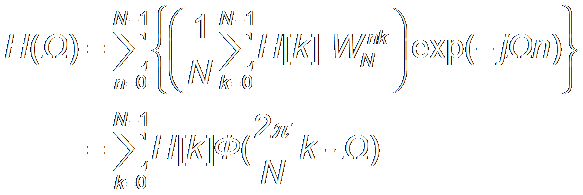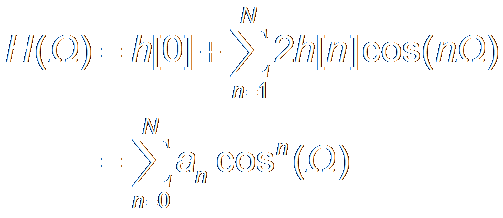|
|
|||
|
|
|
|
|
|
|
|
|
|
|
|
离散傅立叶变换
Frequency Response Sampling Design频率响应采样设计法
Optimal FIR Filter Approximation FIR滤波器的最佳逼近
Discrete Fourier Transform 离散傅立叶变换
Discrete Time Fourier Transform (DTFT):
In Practice: x[n] is Finite in Time; Ω is not Necessarily Continuous all the time
If Finite Spectrum Resolution is Acceptable, Discrete Fourier Transform (DFT) is used.
where k = 0, 2, ..., N-1. Set:
Then DFT of Finite Sample Series, x[n], is:
Inverse DFT (IDFT) is:
Frequency Response Sampling Design频率响应采样设计法
Idea: IDFT of a Filter Frequency Response:
If H[k] is sampled from the Frequency Response of an Ideal Filter Shape Hd(Ω): H[k] = Hd(2πk/N), k = 0, 1, 2, ..., N-1 h[n] is Ideal, at least on Sampled Frequencies.
Evaluation:
H(2πk/N) = H[k] = Hd(2πk/N)
The Bigger N is, The Smoother H(Ω) is, The Less Error we have.
Construct H[k] H[k] = Hk exp(jθk) Even Symmetric Impulse Response: θk= -kπ ; [ Φ(Ω)= -Ω M/2 ] Odd Symmetric Impulse Response: θk= π/2 - kπ ; [ Φ(Ω)= π/2 - Ω M/2 ]
Optimal FIR Filter Approximation FIR滤波器的最佳逼近 Weighted Approximation Error: E(Ω) = W(Ω) [Hd(Ω) - H(Ω)] Idea: To minimize max|E(Ω)| (一致逼近)
Linear Phase FIR Filter (Even Symmetric Impulse Response):
Set x=cos(Ω),
\
Equi-ripple Theorem: Given P(x) is a r-order Polynomial, The maximum of Weighted Approximation Error, Ep(x) = Wp(x) [ Dp(x) - P(x) ] is minimized when P(x) has (r+2) Alternative Points at least, where x1 < x2 < ... < xr+2 P(xi) = -P(xi+1) = ?max|Ep(x)|
Windowed Design is not Optimal by means of Square Mean Error:
is minimized.
Optimal FIR Filter Approximation: (Parks-McClellan Method)
A.V.奥本海姆, R.W.谢弗, J.R巴克 《离散时间信号处理》第二版 西安交通大学出版社 2002, Page 400
|










